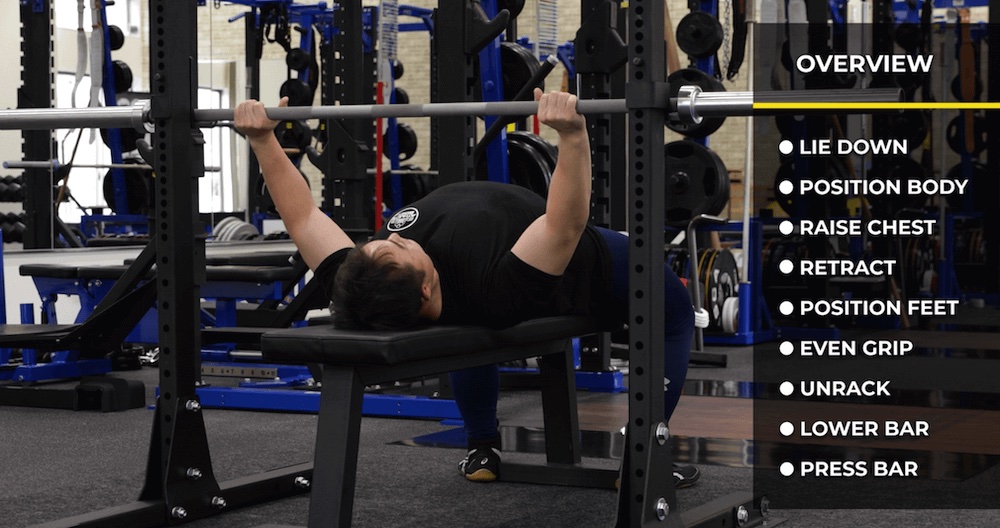
The key to bench pressing a ton of weight is learning how to bench press in a way that suits your body’s mechanics.
People argue online about the specifics, but they miss the bigger picture — different people need to bench press in slightly different ways because body shape, limb lengths, and joint mobility all factor in.
Working with world-class experts, my team and I spent 3 years developing a 46-lesson curriculum to teach you how to master the Squat, Bench Press, and Deadlift.
We call it The Big 3 Basics. It is our first video product. I’d like to share with you one of the 14 bench press videos and with a written guide to benching, which covers part of the course content. I hope you take a ton out of it. Cheers to your future PBs!
VIDEO: HOW TO PERFORM THE PERFECT BENCH PRESS
Here’s an overview of the steps involved in the bench press.
AN OVERVIEW OF THE BENCH PRESS MOVEMENT
It’s best to learn the movement by first practicing with an empty barbell. Here’s an overview of how to perform the bench press movement.
- Lie on the bench and adjust the position of your body relative to the bar.
- Bring your shoulder blades back and raise your chest.
- Adjust your foot position.
- Take an even grip on the bar.
- Slowly take the bar out of the rack and hold it over your shoulders.
- Slowly bring the bar down, touch the chest and press it back up.
- Once you’re back in the top position, put the bar back into the rack.
From here, we’ll take a closer look at each part of the movement.
HOW TO SET UP ON THE BENCH
1) THE BENCH PRESS SETUP ORDER
Here are the steps for how to set up on the bench.
- Sit on the edge of the bench and lie on your back. Be careful not to hit your head on the bar.
- Align the center of your body and the bar. Bring your arms back and adjust the position of your body so that the edges of the bench touch roughly the same parts of your back on both sides.
- Adjust your position front to back. When you’re bench pressing for the first time, a good starting position is where the bar is directly above your eyes. But the appropriate position can change depending on the design of the rack and hook. You may need to re-adjust your position after practicing the movement.
- Grab the bar, bring your shoulder blades together, and raise your chest. It may be helpful to think about pushing out your stomach.
- Plant your feet on the floor, and make sure your entire soles are in contact with the floor.
SHOULDER BLADE RETRACTION
Keeping the shoulder blades back and together during the bench press is essential. It helps you stabilize on the bench, press more weight, and reduces your risk of injury.
Keep your elbows straight and pull your shoulders back. This will pull your shoulder blades back together, and you should feel your upper back muscles tighten. Be careful not to shrug your shoulders, and don’t let your shoulder blade come apart during the movement.
If you have issues with this, see the troubleshooting section at the end.
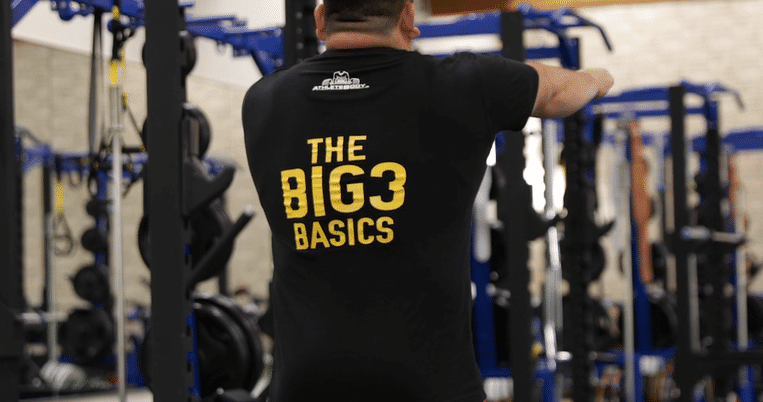
2) HOW TO BENCH PRESS — SETUP CHECKLIST
- Are your feet positioned to be able to push firmly on the floor?
- Are your entire soles in contact with the floor?
- Is your butt in contact with the bench?
- Is your chest raised? (Your lower back should come off the bench.)
- Are both your shoulders in contact with the bench?
- Is your head in contact with the bench?
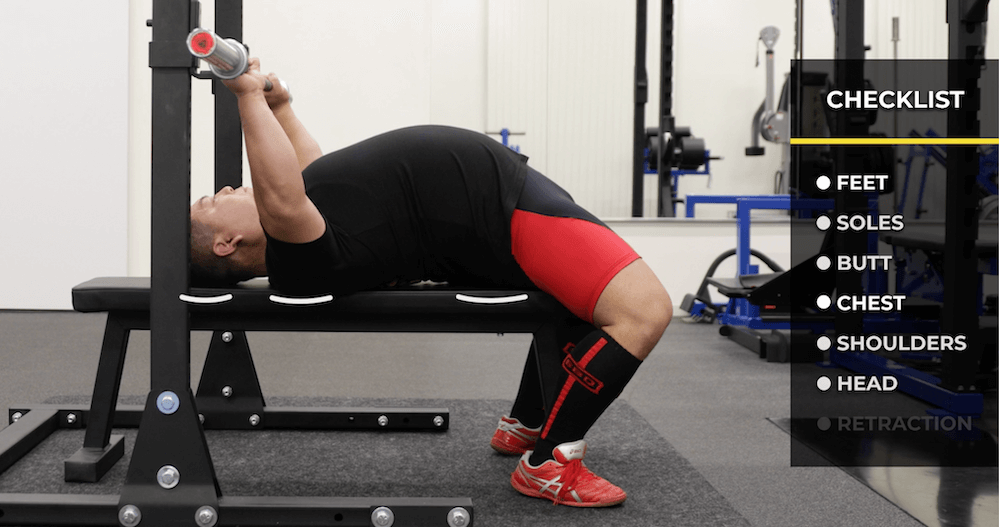
Check to see if there’s any discomfort in your hips, lower back, shoulders, and neck. If you feel any discomfort, make sure your butt, shoulders, and head are in contact with the bench and adjust the positions of your feet, chest posture, and shoulder blade position.
Once you have reviewed these things, consider rewatching the how to bench press video to help you memorize the setup order. Continue to make small adjustments until you find the setup that feels right for you.
HOW TO GRIP THE BAR AND UNRACK IT BEFORE YOU BENCH
3) THE PROPER BAR GRIP FOR THE BENCH PRESS
- Grip the bar about two fist-widths wider than shoulder-width.
- Make sure your grip is even. Both hands should be equally spaced from the center of the bar. You can check the positions of your hands relative to the knurling of the bar to confirm this.
- Grab the bar firmly in your hands.
BENCH PRESS GRIP WIDTH
We want a grip width where the forearms are roughly perpendicular to the bar when lowered to the chest.
A grip width two fist-widths wider than shoulder-width works well for most people. Then try widening it little by little. Each time you widen your grip, perform the movement. Choose the grip width where you feel you can exert the most force.
AVOID BENDING YOUR WRISTS WHEN YOU PRESS
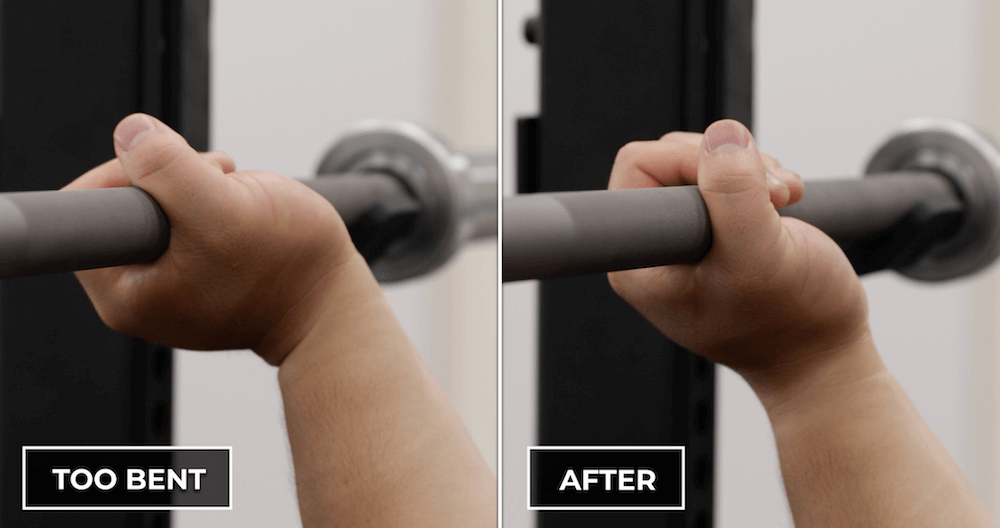
If the wrists bend too far, it can cause pain and discomfort or negatively affect your ability to press hard. Here are four ways to fix this:
- Try gripping the bar deeper in your hands. When you do this, the bar will naturally rest closer to the base of your palm. This may lead to less bending of the wrist and soften the pain and discomfort.
- When you grip the bar, try turning your hands so your fingers point inward.
- Grip as hard as you can. Sometimes this reduces the stress on the wrists.
- Consider using wrist wraps. This will physically limit the bending of the wrists. You want them to be tight, but be careful not to make them so tight that your hands go numb.
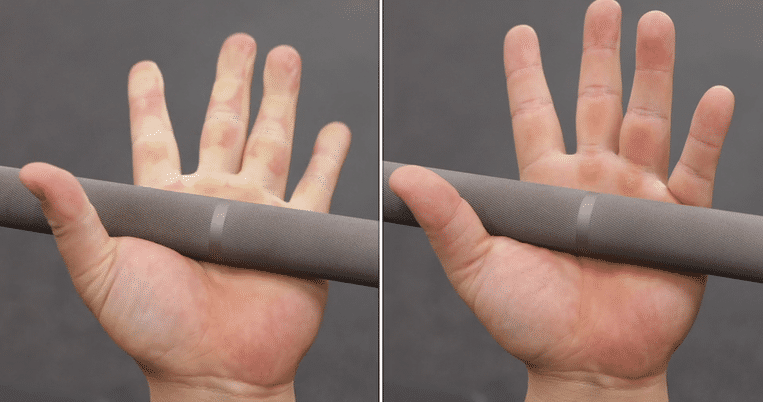
For more detail on learning the right grip position, see Troubleshooting 2: The Grip.
4) HOW TO UNRACK THE BARBELL PRIOR TO THE PRESS
When you grab the bar, make sure your shoulder blades are pulled back together. Then take the bar out of the rack.
Make sure you press the bar straight up to clear the hooks. Lockout your elbows.
Keeping your elbows extended, bring the bar forward directly over your shoulders and hold it in a stable position.
FIXING AN UNSTABLE TOP BENCH PRESS POSITION
If you find that the bar doesn’t feel stable in the top position, make sure your body is in a stable position on the bench. Work your way through the setup checklist in section two above.
Pay particular attention to your chest position. If your chest is not raised, your entire back will likely be in contact with the bench, which is less stable. If you are raising your chest properly, there will be a space between your lower back and the bench.
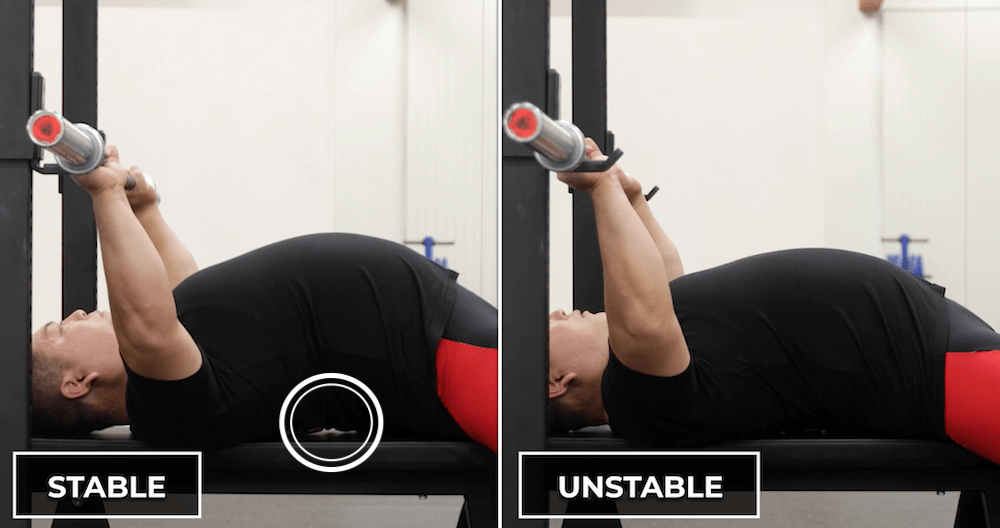
Also, make sure the bar is held directly over your shoulders. If it is over your chest, it will be pulled toward your feet; if it’s over your neck, toward your head.
If you have any issue with bar stability in the top position, see Troubleshooting 4: Unstable Top Position.
THE BENCH PRESS MOVEMENT: LOWERING AND PRESSING
5) LOWERING THE BAR TO THE CHEST (THE DESCENT)
Once the bar is stable over your shoulders, bring it down to your chest. Aim to touch the bar between your nipple line and the pit of your stomach.
During the movement, keep the elbows directly under the bar. When the elbows are under the bar, your arms will be naturally tucked.
Be careful not to flare your elbows far out to the side or keep them too close to your torso. This may be easier to do if you remember your practice with the light bar and try to perform the same movement on the bench.
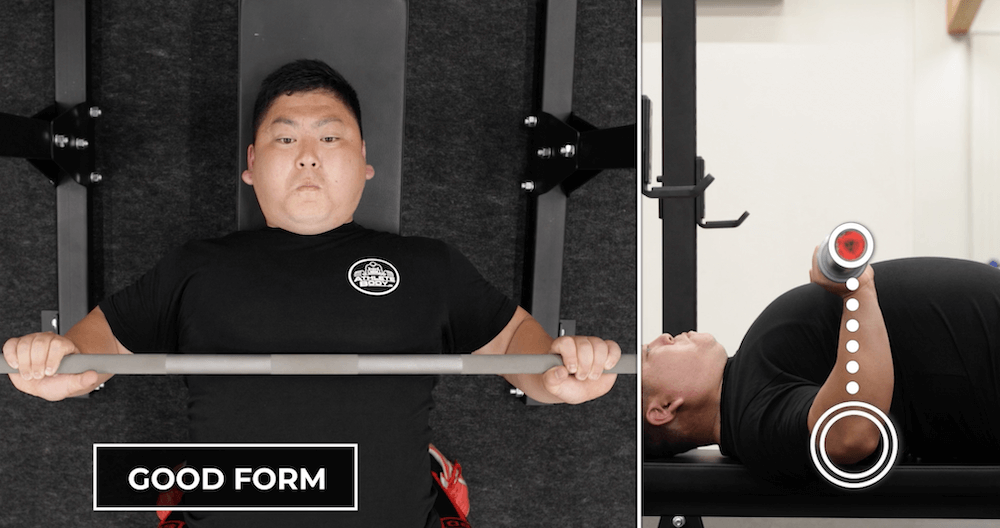
If you’re new to the bench press, use a slow tempo and aim to control the bar. This way, you can hit the same spot on your chest more easily.
6) PRESSING THE BAR BACK UP OVER THE SHOULDERS (THE ASCENT)
When you touch the bar on your chest, reverse the movement and press it back up without a pause.
Press the bar back towards the top position directly over the shoulders. Press it up until your elbows are fully extended. Be careful to keep your chest up and keep your shoulder blades in the same position.
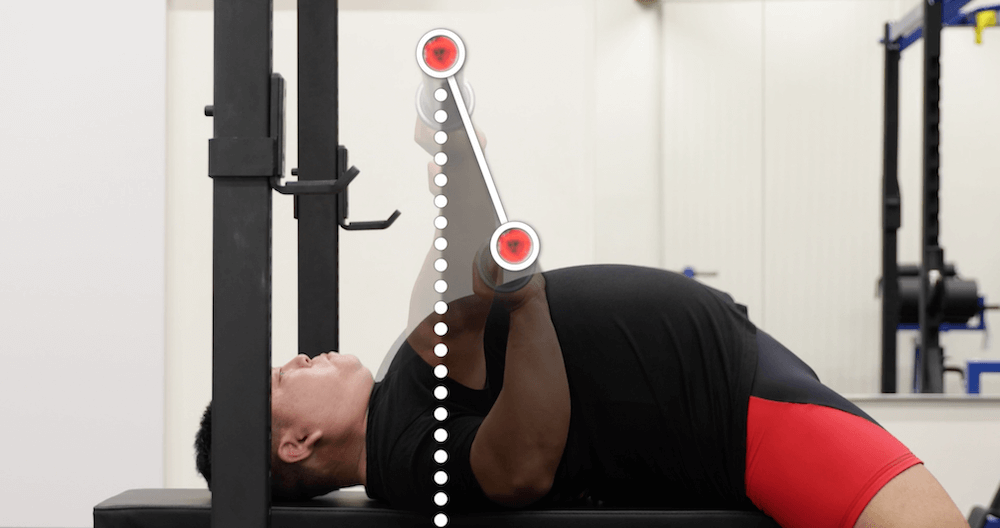
Once you have gone through the checkpoints discussed so far, perform the movement a few times. Through repetition, you will develop your ability to perform the same movement over and over again.
We’ll take a more detailed look at bar path issues in the troubleshooting section.
7) RACKING THE BAR
When you have finished your set, rack the bar.
Keep your elbows extended, move the bar back, and gently hit the pillars of the rack. (These are sometimes referred to as uprights.) If you slam the bar backward too hard, perhaps in excitement at pressing a PR, it will bounce back away from the uprights, and you can miss the hooks. You’ll only make this mistake once.
Once the bar touches the pillars, lower the bar along the uprights and rest it on the hooks. There is no need to look back up to check it will hit the hooks if you lower the bar along the pillars and the hooks are set at an appropriate height in the first place.
HOW TO BENCH PRESS SAFELY
To bench press safely, you not only need to have good technique (as covered above), but you need to know how to use the rack correctly.
We chose to use a standard rack with two pillars when creating this bench press tutorial, as this makes it easier to see the technique points. However, a power rack with four pillars will equally suffice.
You may occasionally wish to have someone watch over and assist you (this is called spotting), but learning how to use the rack should come first so that you have confidence when you train alone.
Finding The Correct Hook Height
The hook height should be adjusted to your arm length.
Ideally, when you press the bar off the hooks, the bar should be a couple of inches (~4-5 cm) above the hooks.
If the hooks are too high, you will have to move your shoulders forward to unrack the bar. This will bring your shoulder blades out of their position. Also, it can be difficult to rerack the bar, and this can be dangerous with heavy loads.
If the hooks are too low, you will have to use more energy, negatively affecting your performance.
If you are not sure how high the hooks should be, start with a low placement and adjust upwards.

Finding The Best Safety Pin Height
The arm-like things further down are called safety pins, or less commonly, safety arms. (In a power rack, they are called safety bars.) They are designed to catch the bar, and they are particularly useful when performing the bench press alone.
Set the safety pins a couple of inches (~4-5 cm) below the bar when it is at the bottom of the range of motion. Make sure you set this when you are in your chest up posture, not relaxed. This way, when you relax your position, it will rest on the pins.
If you are ever unable to lift the bar to the top position, lower it to your chest and relax your chest up posture. When you do this, the bar should rest on the safety pins. Roll the bar towards your feet and get out of the rack.
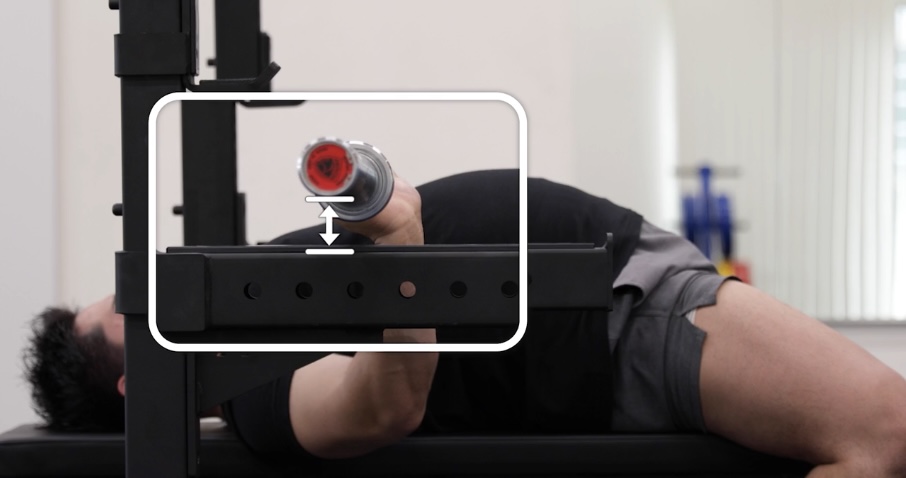
How To Spot The Bench Press Correctly
When pushing yourself to the limits towards the end of a set, or when testing one-rep maxes, though you could rely on the rack, it is a good idea to be spotted.
But getting a spot doesn’t automatically mean you’ll be fine. It requires teamwork.
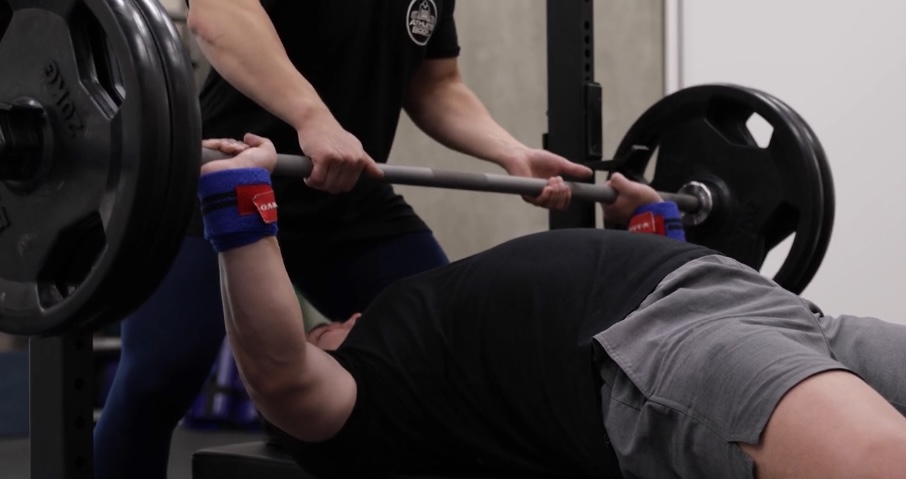
The Steps To Correctly Spot The Bench:
- When unracking the bar, the spotter should gently hand over the bar. The lifter should lead the motion of unracking the bar, and the spotter should provide the least amount of support necessary to unrack the bar safely.
- When the lifter is able to hold the bar stably, the spotter should carefully let go and step back to not interfere with the lifter’s performance. You can’t expect them to perform their best if your sweaty crotch is 3 inches above their nose.
- Usually, while the lifter is performing the movement, the spotter doesn’t touch the bar.
- Stay and keep a close eye on the movement so you can step forward and assist any time it is needed. Do not get distracted by your phone or start chatting with someone.
- If the lifter cannot complete the movement on their own, carefully grab the bar with both hands.
- Be careful not to disrupt the lifter’s movement when providing support.
- Be careful not to pull the bar up too far — it can pull the lifter’s shoulder blades out of position, destabilizing them.
- When the movement is complete, help guide the bar into the rack. Do not jerk or slam it, as it could bounce away from the rack and miss the pins.

The spotter can use an overhand or alternating grip. The alternating grip may enable a stronger pull, but this grip has a tendency to turn the bar. So if you use this grip, be careful to pull the bar straight up.
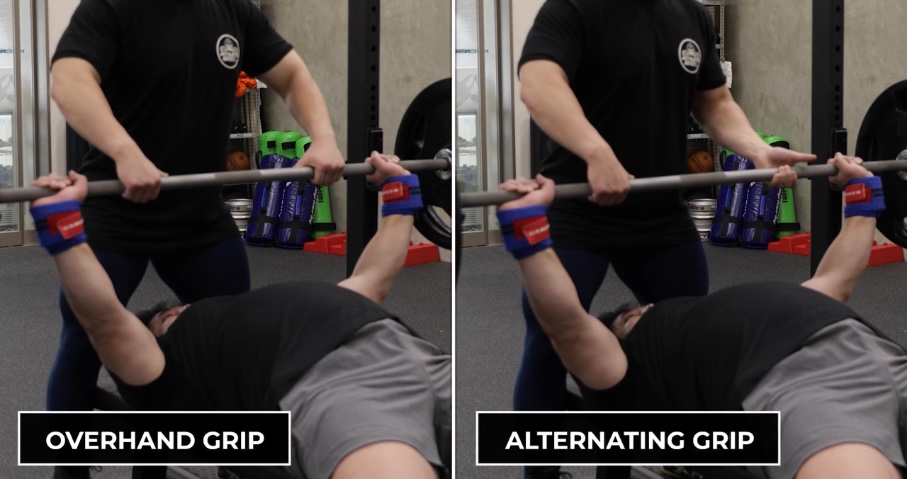
Advice For Lifters When Getting A Spot When They Press
Incompetent spotters can cause you an injury, so it’s best not to ask strangers. If you have no other choice, it may be prudent to test their competence with a load you can manage first. Look around the gym to see who is doing it correctly first, before you ask.
Even if you are confident in the abilities of the person spotting you, mistakes happen, so make sure you set the hooks and safety pins correctly.
When the spotter comes in to provide support, continue to lift the bar without relaxing. Do not expect the spotter to pull the bar on their own.
TROUBLESHOOTING THE BENCH PRESS
GETTING THE RIGHT FOOT POSITION
The foot position when bench pressing is important. It affects how high your chest will reach and how stable your body will be.
FEET TOWARDS HEAD
If you bring your feet towards your head, it may allow you to raise your chest higher. But the closer to your head you bring your feet, the more difficult it is to keep your entire foot on the floor, compromising leg drive. Also, if this forces you to arch your body too far, it can lead to pain and discomfort in the lower back and hips.
FEET OUT IN FRONT
If you put your feet out in front of your knees, it can reduce the arch in the lower back, and you might find it easier to get in position. But the further out your feet are, the more difficult it will be to raise your chest. Also, there’s more of a risk of your feet slipping when you push on the floor with your legs.
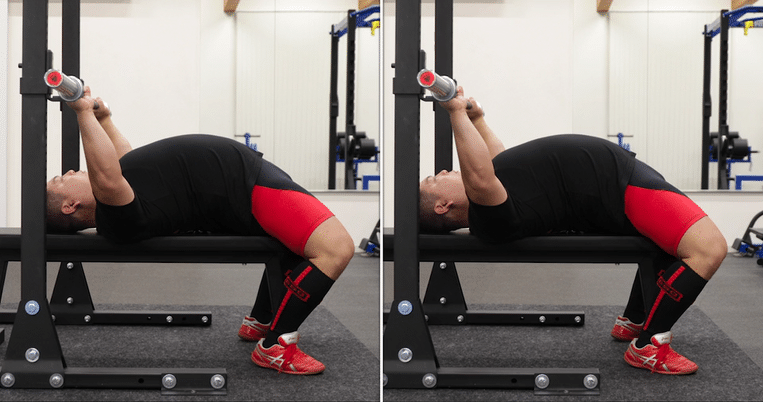
BENCH PRESS FOOT WIDTH
If you spread your legs and put your feet out to the side, you may find it easier to tighten the muscles in your butt and stabilize your body on the bench. But the further out your feet are, the more open your hips will be, which may cause discomfort.
There is no one-size-fits-all foot position, but you need to be able to stabilize your body and push hard on the floor with your legs when you bench. Try different placements and see what works for you.
For a more detailed look at foot position issues, see Troubleshooting 3: Foot Position.
SHOULDER PAIN AND FINDING THE CORRECT BAR PATH
The bar should move diagonally from over the shoulders to the chest. The bar touches the chest between the nipple line and the pit of your stomach, and the elbows should be kept under the bar. When this goes wrong, it can cause shoulder pain. There are a few common mistakes.
DON’T PRESS TO THE NECK
If the bar touches your chest closer to your neck, you might feel stress around your shoulders. You’ll notice that the elbows flare out to the side when you bench.
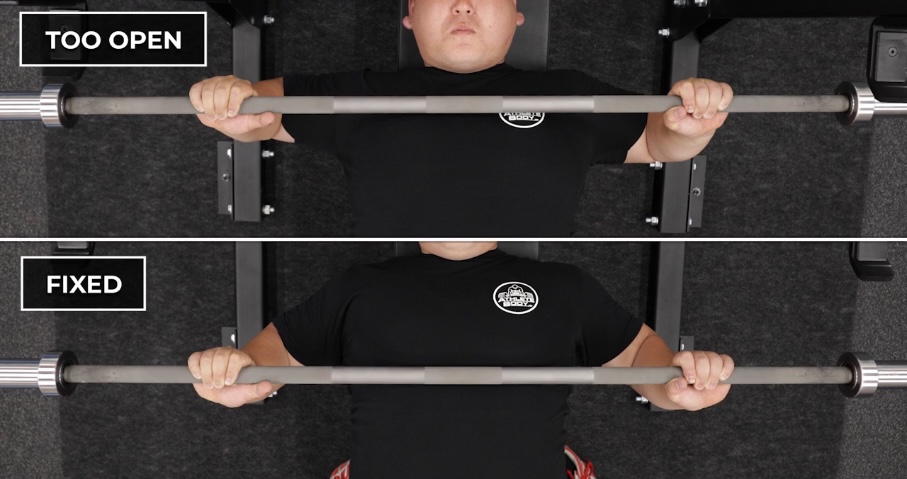
In this case, try lowering the bar to a point lower on your chest. Your elbow positions will continue to be directly under the bar, and the bar will move diagonally from the shoulders to the chest. When your elbows are naturally tucked, it reduces stress around your shoulders.
HOW MUCH TO ARCH WHEN YOU BENCH
The purpose of the arch when bench pressing is to create a stable position to press from.
Arching Too Little
If you haven’t raised your chest enough, you may not be able to press the bar effectively, even if you are lowering the bar to the right point on your body.
When this happens, if you view the bar path from the side, you’ll see that the bar has to move across a greater distance. If this is happening, push your chest out and bring your shoulder blades together before performing your bench presses.
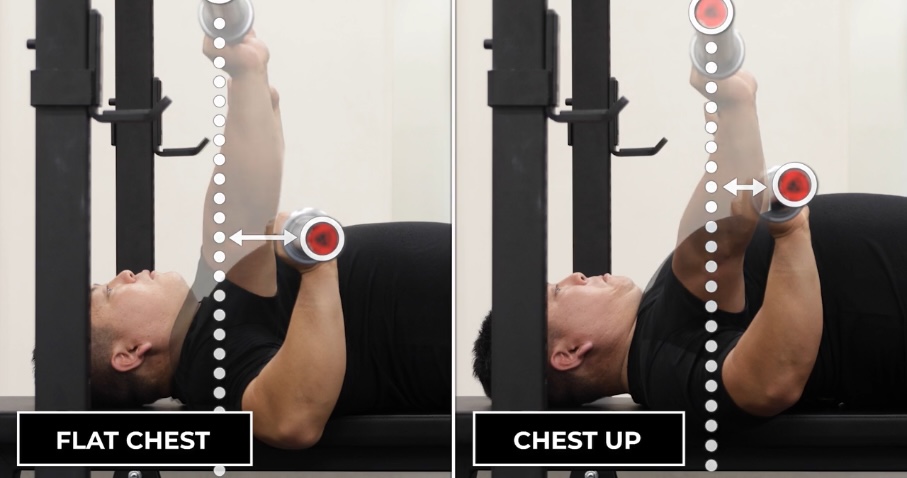
Arching Too Much
You should arch no further than the point where your butt is still in contact with the bench, and your feet are fully in contact with the floor. Anything further than this is not stable.
However, you should avoid the kind of extreme arch positions you see in bench press competitions when doing your general strength training.
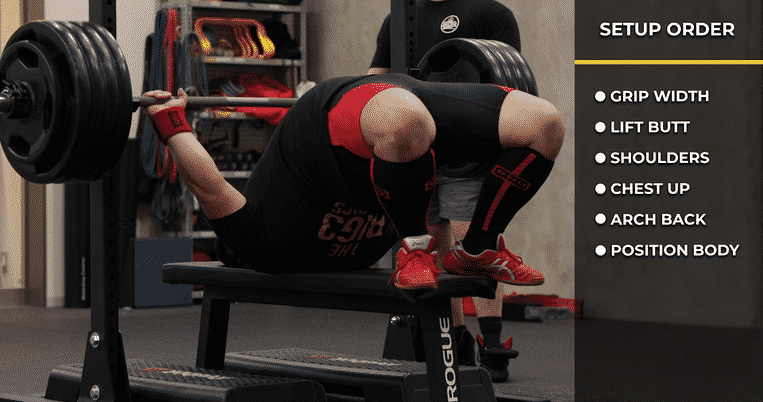
High chest positions allow for a shorter range of motion to be used and more weight to be lifted. This is good when competing but a bad idea for your regular workouts. Fuller ranges of motion are better for building muscle, and how much muscle mass you have largely determines how strong you can potentially become.
For a more detailed look at bench pressing with a more optimal bar path, see Troubleshooting 5: The Bar Path.
SHOULDER BLADE POSITION
When you perform the bench press, you may find your shoulder blades coming out of position. On the left, the shoulder blades have moved apart. When this happens, you will likely be unable to keep the chest up posture, and your body will not be as stable on the bench.
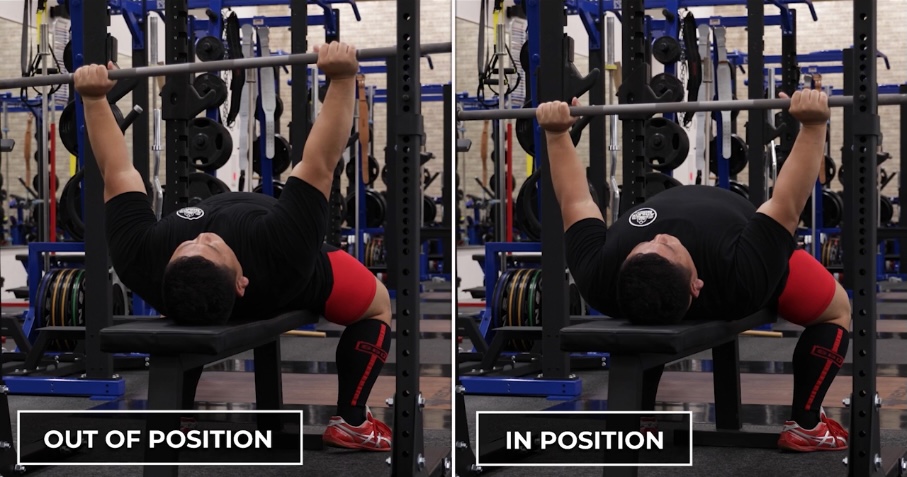
SHOULDER BLADE POSITION ISSUES WHEN UNRACKING
If the shoulder blades come out of position when you unrack the bar, check the hook height. If the hooks are too high, your elbows will be extended when you grab the bar. To unrack the bar from this position, you will have to move your shoulders.
SHOULDER BLADE POSITION ISSUES WHEN YOU PRESS
If the shoulder blades come out of position at the end of the bench press, make sure you only press the bar until the elbows are extended. Do not press further from this point by moving your shoulders. You may hear this referred to as maintaining scapular retraction.
If you have any issues with getting the right shoulder blade positioning, see Troubleshooting 6: Shoulder Blade Position and Troubleshooting 7: Practicing Shoulder Blade Retraction.
BENCH PRESS FORM FAQ
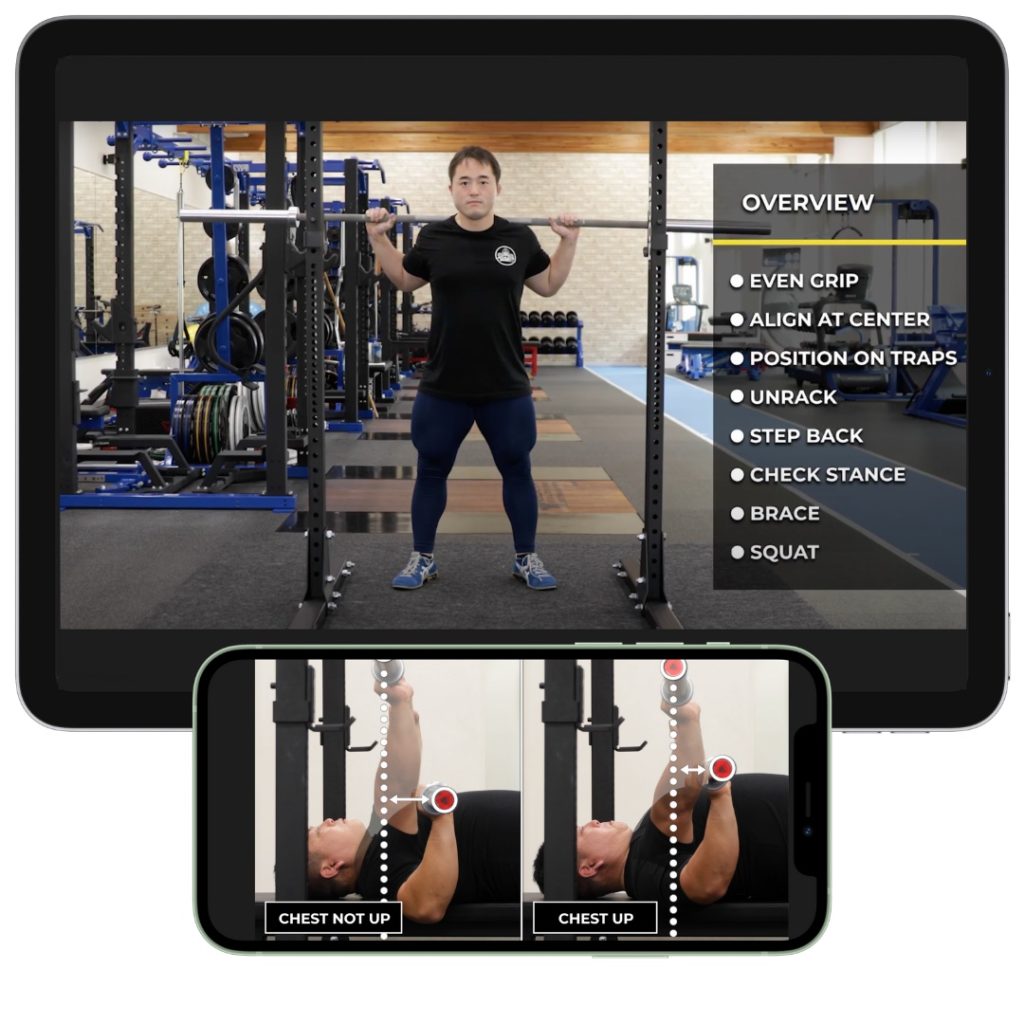
Thank you for reading. If you found this Bench Press tutorial useful, please share it with a friend who might also. 🙏🏻
You can purchase full access to The Big 3 Basics here.
You’ll get access to all 14 Bench Press tutorial videos and a further 32 videos teaching the Squat and Deadlift. I’m so confident you’ll be delighted with it, there’s a full, no-questions-asked, money-back guarantee. 💪🏻